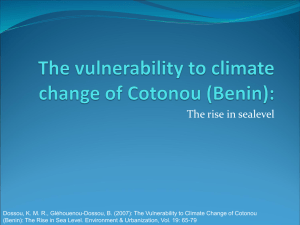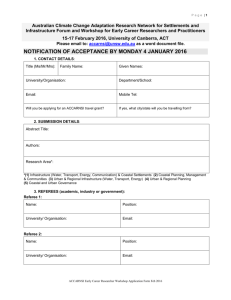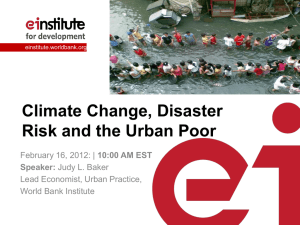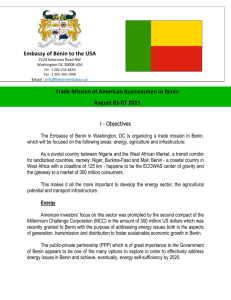Andhika Rutten #1572636 (VU) * still waiting for my UVA student
advertisement
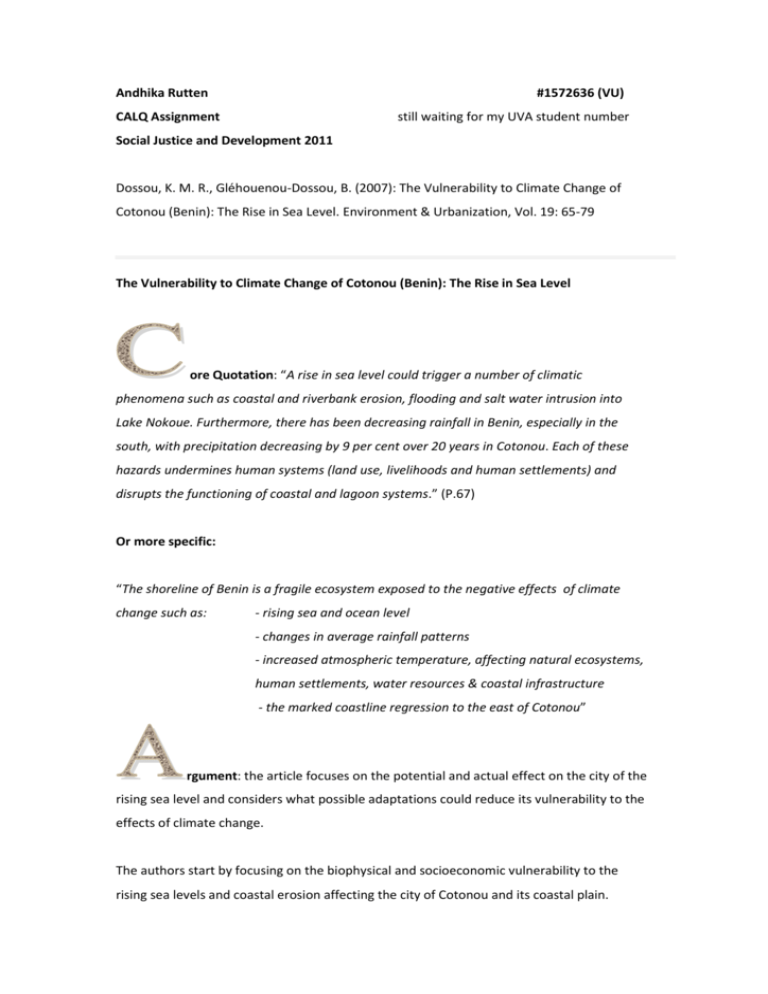
Andhika Rutten #1572636 (VU) CALQ Assignment still waiting for my UVA student number Social Justice and Development 2011 Dossou, K. M. R., Gléhouenou-Dossou, B. (2007): The Vulnerability to Climate Change of Cotonou (Benin): The Rise in Sea Level. Environment & Urbanization, Vol. 19: 65-79 The Vulnerability to Climate Change of Cotonou (Benin): The Rise in Sea Level ore Quotation: “A rise in sea level could trigger a number of climatic phenomena such as coastal and riverbank erosion, flooding and salt water intrusion into Lake Nokoue. Furthermore, there has been decreasing rainfall in Benin, especially in the south, with precipitation decreasing by 9 per cent over 20 years in Cotonou. Each of these hazards undermines human systems (land use, livelihoods and human settlements) and disrupts the functioning of coastal and lagoon systems.” (P.67) Or more specific: “The shoreline of Benin is a fragile ecosystem exposed to the negative effects of climate change such as: - rising sea and ocean level - changes in average rainfall patterns - increased atmospheric temperature, affecting natural ecosystems, human settlements, water resources & coastal infrastructure - the marked coastline regression to the east of Cotonou” rgument: the article focuses on the potential and actual effect on the city of the rising sea level and considers what possible adaptations could reduce its vulnerability to the effects of climate change. The authors start by focusing on the biophysical and socioeconomic vulnerability to the rising sea levels and coastal erosion affecting the city of Cotonou and its coastal plain. Coastal erosion and rising sea level causing threats to for example residential districts, tourism sector, loss of human settlements, impacts on human health and salt intrusion. They also discuss the ways in which vulnerability could be reduced. Both researchers send a critical note by discussing the decisions that Benin made to reduce its vulnerability by placing groynes, to stabilize the coastline and relocate activities, infrastructure and communities. The researchers state that local NGO should play their advocacy role drawing politicians’ attention to the other climatic hazards that could further impoverish the people and by raising awareness of local communities, and to encourage them to take responsibility regarding land that is already identified as affected and protection of environment through appropriate behaviour. ink: this article can be linked with the article written by the authors McGranahan, Balk and Anderson: “The rising tide: assessing the risks of climate change and human settlements in low elevation coastal zones”. This article also focus on human settlements, and in particular settlements, in low elevation coastal zones. Both articles are stating that “settlements in coastal lowlands are especially vulnerable to risks resulting from climate change, yet these lowlands are densely settled and growing rapidly” and the authors of both article advice that reducing the risk of disasters related to the climate change in coastal settlements require a combination of mitigation, migration and settlement modification. The article of Dossou is focused on the case of Benin while the paper of McGrahanan (et all) undertakes a global review of the population and urban settlements patterns in the Low Elevation Coastal Zones (LECZ). But both papers show that urbanization is driving a movement in population towards the vulnerable coast. uestion: Benin has prepared two scenarios by focusing on the technological adaptation and the relocation of activities. Do you think they have done well by focusing on these two aspects? Or do you think, like the researchers have advised, that the focus should (also) lie (more) on raising awareness of local communities? What is most important considering social justice and the effects of climate change on the long term?
